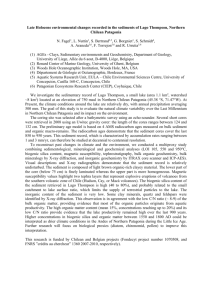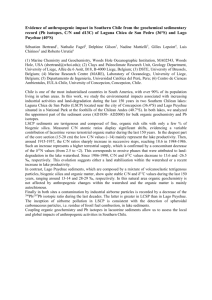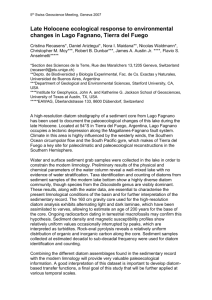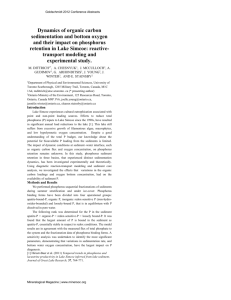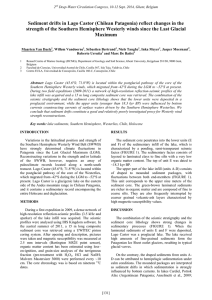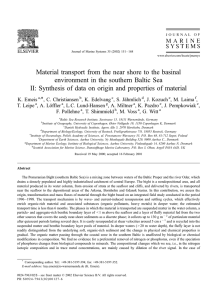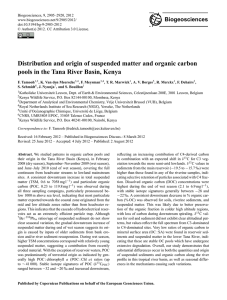Late Holocene environmental changes recorded in the sediments of Lago
advertisement
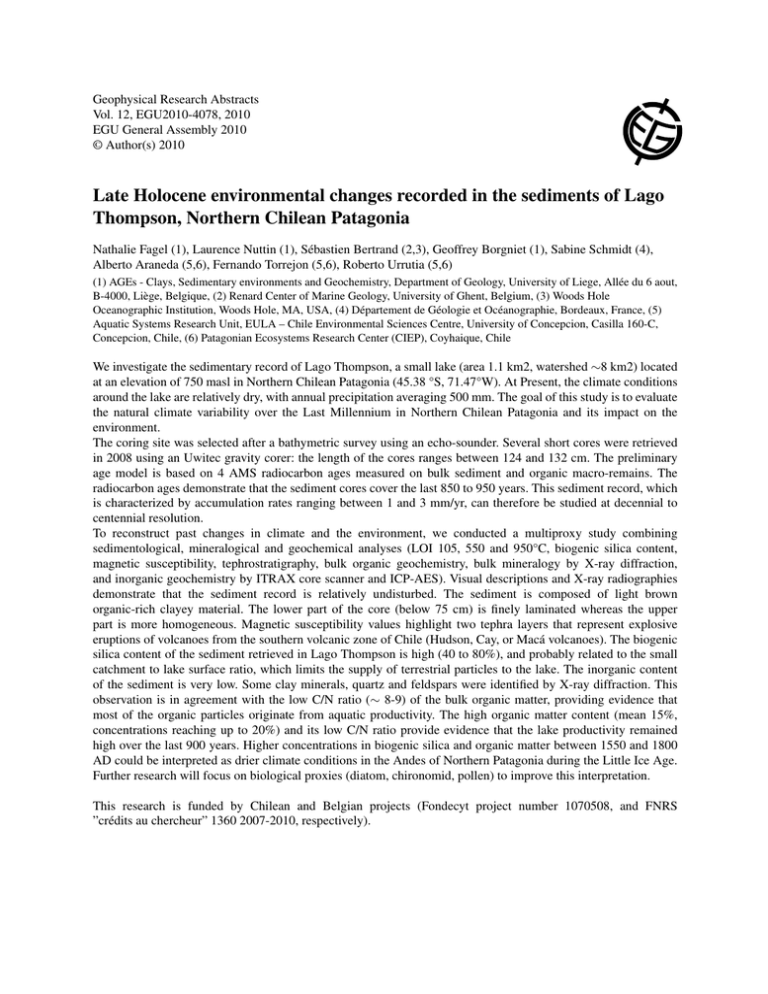
Geophysical Research Abstracts Vol. 12, EGU2010-4078, 2010 EGU General Assembly 2010 © Author(s) 2010 Late Holocene environmental changes recorded in the sediments of Lago Thompson, Northern Chilean Patagonia Nathalie Fagel (1), Laurence Nuttin (1), Sébastien Bertrand (2,3), Geoffrey Borgniet (1), Sabine Schmidt (4), Alberto Araneda (5,6), Fernando Torrejon (5,6), Roberto Urrutia (5,6) (1) AGEs - Clays, Sedimentary environments and Geochemistry, Department of Geology, University of Liege, Allée du 6 aout, B-4000, Liège, Belgique, (2) Renard Center of Marine Geology, University of Ghent, Belgium, (3) Woods Hole Oceanographic Institution, Woods Hole, MA, USA, (4) Département de Géologie et Océanographie, Bordeaux, France, (5) Aquatic Systems Research Unit, EULA – Chile Environmental Sciences Centre, University of Concepcion, Casilla 160-C, Concepcion, Chile, (6) Patagonian Ecosystems Research Center (CIEP), Coyhaique, Chile We investigate the sedimentary record of Lago Thompson, a small lake (area 1.1 km2, watershed ∼8 km2) located at an elevation of 750 masl in Northern Chilean Patagonia (45.38 °S, 71.47°W). At Present, the climate conditions around the lake are relatively dry, with annual precipitation averaging 500 mm. The goal of this study is to evaluate the natural climate variability over the Last Millennium in Northern Chilean Patagonia and its impact on the environment. The coring site was selected after a bathymetric survey using an echo-sounder. Several short cores were retrieved in 2008 using an Uwitec gravity corer: the length of the cores ranges between 124 and 132 cm. The preliminary age model is based on 4 AMS radiocarbon ages measured on bulk sediment and organic macro-remains. The radiocarbon ages demonstrate that the sediment cores cover the last 850 to 950 years. This sediment record, which is characterized by accumulation rates ranging between 1 and 3 mm/yr, can therefore be studied at decennial to centennial resolution. To reconstruct past changes in climate and the environment, we conducted a multiproxy study combining sedimentological, mineralogical and geochemical analyses (LOI 105, 550 and 950°C, biogenic silica content, magnetic susceptibility, tephrostratigraphy, bulk organic geochemistry, bulk mineralogy by X-ray diffraction, and inorganic geochemistry by ITRAX core scanner and ICP-AES). Visual descriptions and X-ray radiographies demonstrate that the sediment record is relatively undisturbed. The sediment is composed of light brown organic-rich clayey material. The lower part of the core (below 75 cm) is finely laminated whereas the upper part is more homogeneous. Magnetic susceptibility values highlight two tephra layers that represent explosive eruptions of volcanoes from the southern volcanic zone of Chile (Hudson, Cay, or Macá volcanoes). The biogenic silica content of the sediment retrieved in Lago Thompson is high (40 to 80%), and probably related to the small catchment to lake surface ratio, which limits the supply of terrestrial particles to the lake. The inorganic content of the sediment is very low. Some clay minerals, quartz and feldspars were identified by X-ray diffraction. This observation is in agreement with the low C/N ratio (∼ 8-9) of the bulk organic matter, providing evidence that most of the organic particles originate from aquatic productivity. The high organic matter content (mean 15%, concentrations reaching up to 20%) and its low C/N ratio provide evidence that the lake productivity remained high over the last 900 years. Higher concentrations in biogenic silica and organic matter between 1550 and 1800 AD could be interpreted as drier climate conditions in the Andes of Northern Patagonia during the Little Ice Age. Further research will focus on biological proxies (diatom, chironomid, pollen) to improve this interpretation. This research is funded by Chilean and Belgian projects (Fondecyt project number 1070508, and FNRS ”crédits au chercheur” 1360 2007-2010, respectively).
